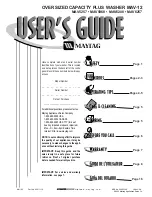
Information for test institute
Information on energy labelling
Information sheet, in compliance with Commission Delegated Regulation (EU) No. 1059/2010
Gorenje
Model designation:
Number of standard place settings:
Energy efficiency class:
Annual energy consumption(AE
C
):
GV55110
10 1)
A++
211 kWh per year
2)
Energy consumption of the standard cleaning cycle(E
t
):0.74 kWh
Power consumption
Off-mode (P
o
):
Left-on mode (P
l
):
Annual water consumption (AW
C
):
Drying efficiency class:
Standard programme:
Programme time for the standard cleaning cycle:
Duration of the left-on mode (T
l
):
Noise emissions:
Construction:
1)
In accordance with standard, EN 50242.
0.45 W
0.49 W
2520 litres per year
3)
A 4)
Eco wash
5) , no options
190 minutes
30 minutes
47 dB(A) re 1 pW
Integrated product
2)
Based on 280 standard cleaning cycles with a cold water connection and consumption in accordance with energy saving mode. The actual
energy consumption depends on how the machine is used.
3)
Based on 280 standard cleaning cycles. The actual water consumption depends on how the machine is used.
4)
On a scale from G (least efficient) to A (most efficient).
5)
This dishwashing programme is the standard cleaning cycle used to compile the energy labelling information. It is intended for washing
normally dirty dishes and is the most effective programme in terms of combined energy and water consumption.
Technical data
Height:
Width:
Depth:
Water pressure:
815 mm
448 mm
550 mm
0.04
–1.0 MPa
Electrical connection: See serial number plate
Rated power:
See serial number plate
A
rt
.
No.
:
54267
4
.
Re
v.
0
4
.
W
e
r
e
se
rve
th
e
r
ig
h
t
to
m
a
ke
ch
a
n
g
e
s.
18

































